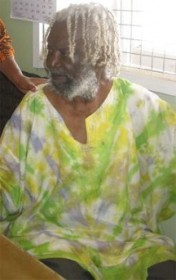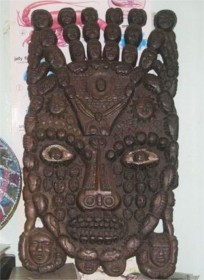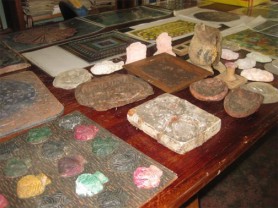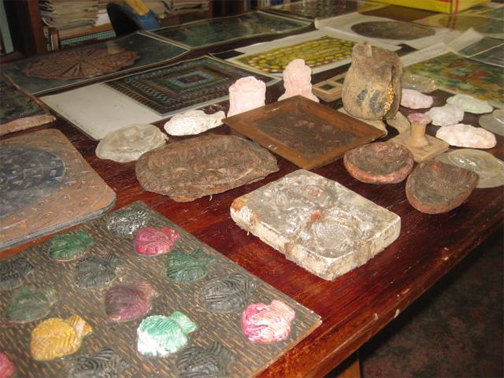Although renowned artist, Phillip Moore of Manchester, Corentyne is now 88 years old, he still produces works of art and has not lost his talent. “When you are an artist,” he says, “you can’t stop thinking.”

Moore who began life as an ordinary farm-boy before becoming a well-known artist had sold 150 of his works to the government, and the collection is being displayed at the National Gallery of Art in Castellani House. And as he proudly put it, “Guyana is enriched with some of my work.”
“A lot of people heard about me,” he said; “I sold my collection to them and they take them all over the world.”
He told this newspaper that even though he was good at art at a young age he did not know he would “become a talented and universal artist and become so famous.” In fact his career started “through dreams and visions” at age 19.
“At an early age I got to understand that the mind is very powerful and creative, and if you know how to deal with yourself you can get great things coming from your mind,” he said.
After he finished school, he related, he started working with his father on his farm. He wanted to become a policeman but that did not work out. He then wrote an examination to become a pupil-teacher but was not successful at that either.

His humble parents, knowing that he had potential, wanted him to become a lawyer.
He then started working “at a canefield” to supplement their income and to save the money for his studies. But that too was not to be.With a chuckle he remarked that “some divine intervention wanted me to become an artist.”
He explained that it all started one Friday as he was working in the field. “A wind came and encircled me and then something inside me said ‘so long you wanted to carve a man’s head out of wood; get up and do it.’”
He then took his cutlass and cut a piece of wood from a tree and carved a man’s head perfectly, although he had doubted he would ever be able to do it. After that he said persons started telling him, “You got all that talent and you working so hard on the farm.”
Although he had discovered his hidden talent he still kept going to the backdam to work. “Not just because I was making a living but because I would get to cut the wood which I used to carve at nights,” he explained.
As his talent grew, so did the demand for his pieces, and he started making his own moulds “so I could do mass production.”
1763 monument
He kept on experimenting with different designs and did “fantastic work until persons from the US came and saw that my work was so original and they hired me to work at the Princeton University.”
Moore later became a professor at the university and had a meditation museum there “where art became a symbol of deeper meaning in life.”
His talent was further highlighted when he answered an advertisement in the local newspapers in 1970, and he submitted an entry for the design of the 1763 monument.
He was elated when his entry was approved. He subsequently got down to designing the four foot model at the university. It was later sent to England where the statue was cast in bronze and shipped to Guyana in 1972.

The father of five children, two of whom are alive, said he returned to Guyana and started working at the Burrowes School of Art. Here he always taught students that “…art is a form of visual education to stimulate people.”
Although he suffers from ill-health, the veteran artist is still involved in imparting his skills and was recently the coordinator of a four-day art/craft workshop at Lichfield, West Coast Berbice, sponsored by the Inter-American Development Bank.
The students were inspired by Moore’s great work and said they had learnt a lot from him.
This newspaper caught up with him at the workshop where he displayed some of his pieces.
He told this newspaper that most of his work carries a meaning, and he proudly displayed a sculpture titled the ‘Masking of Martin,’ which shows Martin Luther King with a number of “heads” around him.
The piece, he said, depicted that “many other people fought for the redemption of black people from slavery besides him [King].” However, he continued, “At least Martin Luther King was a sort of promise coming to Barack Obama – the first African president of the US.”
What made the piece even more special, he said, was that “a woman from France bought it but asked me to keep it in Guyana to inspire people.”
Moore has also done a lot of work in the field of cricket titled ‘Cricket Fantasy,’ and these pieces were exhibited during World Cup Cricket in Guyana.
He recalled one instance where persons came from America and inquired about the price for one of his pieces, and he told them US$5,000. He said they did not have enough money and paid him only US$50. “But when they returned they paid me the balance through my bank account.”
Moore is also a poet and composer. And even though his songs have never been produced, he is optimistic that, “One day my songs would become best sellers and I would make millions.”
Where religion is concerned, his view is that “The general population of the world needs to understand that each man is a recipient of God Almighty… only so peace can come into this world.”
His son, Phillip Moore, Jr with whom he resides on the Corentyne said he had followed in his father’s footsteps and had been in the sculpture business as well.

